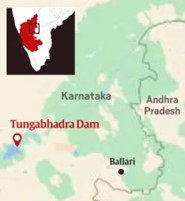Recently, India has successfully conducted the maiden flight test of the long-range glide bomb (LRGB) 'Gaurav' from Long Wheeler’s Island coast, Odisha.
Long-Range Glide Bomb
References
Recently 109 varieties of 61 Field and Horticultural crops were released in the trial sites of PUSA, New Delhi.
References
Recently, India has begun negotiations with the UK to enhance collaboration on critical minerals under the new UK-India Technology Security Initiative (TSI).
UK-India Technology Security Initiative (TSI)
References
A flood alert has been issued in Karnataka’s Koppal district after one of the 33 crest gates of the Tungabhadra dam was washed away.

o The reservoir covers an area of 378 sq km, primarily in Karnataka’s Vijayanagar district.
o It is one of the major reservoirs in South India, supplying water for irrigation, industrial use, and drinking water to Karnataka and Andhra Pradesh.
Tungabhadra Dam
References